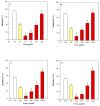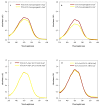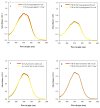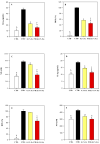Xanthophyll-Rich Extract of Phaeodactylum tricornutum Bohlin as New Photoprotective Cosmeceutical Agent: Safety and Efficacy Assessment on In Vitro Reconstructed Human Epidermis Model
- PMID: 37241930
- PMCID: PMC10222380
- DOI: 10.3390/molecules28104190
Xanthophyll-Rich Extract of Phaeodactylum tricornutum Bohlin as New Photoprotective Cosmeceutical Agent: Safety and Efficacy Assessment on In Vitro Reconstructed Human Epidermis Model
Abstract
The nutritional and health properties of algae make them perfect functional ingredients for nutraceutical and cosmeceutical applications. In this study, the Phaeodactylum tricornutum Bohlin (Phaeodactylaceae), a pleiomorphic diatom commonly found in marine ecosystems, was investigated. The in vitro culture conditions used favoured the fusiform morphotype, characterized by a high accumulation of neutral lipids, as detected by fluorescence microscopy after BODIPY staining. These data were confirmed by HPLC-DAD-APCI-MS/MS analyses carried out on the ethanolic extract (PTE), which showed a high content of xanthophylls (98.99%), and in particular of fucoxanthin (Fx, 6.67 g/100 g PTE). The antioxidant activity (ORAC, FRAP, TEAC and β-carotene bleaching) and photostability of PTE and Fx against UVA and UVB rays were firstly evaluated by in vitro cell-free assays. After this, phototoxicity and photoprotective studies were carried out on in vitro reconstructed human epidermidis models. Results demonstrated that PTE (0.1% Fx) and 0.1% Fx, both photostable, significantly (p < 0.05) reduce oxidative and inflammatory stress markers (ROS, NO and IL-1α), as well as cytotoxicity and sunburn cells induced by UVA and UVB doses simulating the solar radiation, with an excellent safety profile. However, PTE proved to be more effective than Fx, suggesting its effective and safe use in broad-spectrum sunscreens.
Keywords: Phaeodactylum tricornutum bohlin; antioxidant activity; carotenoids; fucoxanthin; microalgae; microscopy; photoprotection; photostability; phototoxicity; phytochemical analysis.
Conflict of interest statement
The authors declare no conflict of interest.
Figures











Similar articles
-
Valorization of Phaeodactylum tricornutum for integrated preparation of diadinoxanthin and fucoxanthin.Bioresour Technol. 2023 Oct;385:129412. doi: 10.1016/j.biortech.2023.129412. Epub 2023 Jun 28. Bioresour Technol. 2023. PMID: 37390934
-
Development of new green processes for the recovery of bioactives from Phaeodactylum tricornutum.Food Res Int. 2017 Sep;99(Pt 3):1056-1065. doi: 10.1016/j.foodres.2016.04.022. Epub 2016 Apr 23. Food Res Int. 2017. PMID: 28865617
-
Photo-Oxidative Stress-Driven Mutagenesis and Adaptive Evolution on the Marine Diatom Phaeodactylum tricornutum for Enhanced Carotenoid Accumulation.Mar Drugs. 2015 Sep 29;13(10):6138-51. doi: 10.3390/md13106138. Mar Drugs. 2015. PMID: 26426027 Free PMC article.
-
A Review of Fucoxanthin Biomanufacturing from Phaeodactylum tricornutum.Bioprocess Biosyst Eng. 2024 Dec;47(12):1951-1972. doi: 10.1007/s00449-024-03039-8. Epub 2024 Jun 17. Bioprocess Biosyst Eng. 2024. PMID: 38884655 Review.
-
Phaeodactylum tricornutum: A Diatom Cell Factory.Trends Biotechnol. 2020 Jun;38(6):606-622. doi: 10.1016/j.tibtech.2019.12.023. Epub 2020 Jan 21. Trends Biotechnol. 2020. PMID: 31980300 Review.
Cited by
-
Carotenoids for Antiaging: Nutraceutical, Pharmaceutical, and Cosmeceutical Applications.Pharmaceuticals (Basel). 2025 Mar 13;18(3):403. doi: 10.3390/ph18030403. Pharmaceuticals (Basel). 2025. PMID: 40143179 Free PMC article. Review.
References
-
- Stiefvatter L., Neumann U., Rings A., Frick K., Schmid-Staiger U., Bischoff S.C. The Microalgae Phaeodactylum tricornutum Is Well Suited as a Food with Positive Effects on the Intestinal Microbiota and the Generation of SCFA: Results from a Pre-Clinical Study. Nutrients. 2022;14:2504. doi: 10.3390/nu14122504. - DOI - PMC - PubMed
MeSH terms
Substances
LinkOut - more resources
Full Text Sources
Miscellaneous

